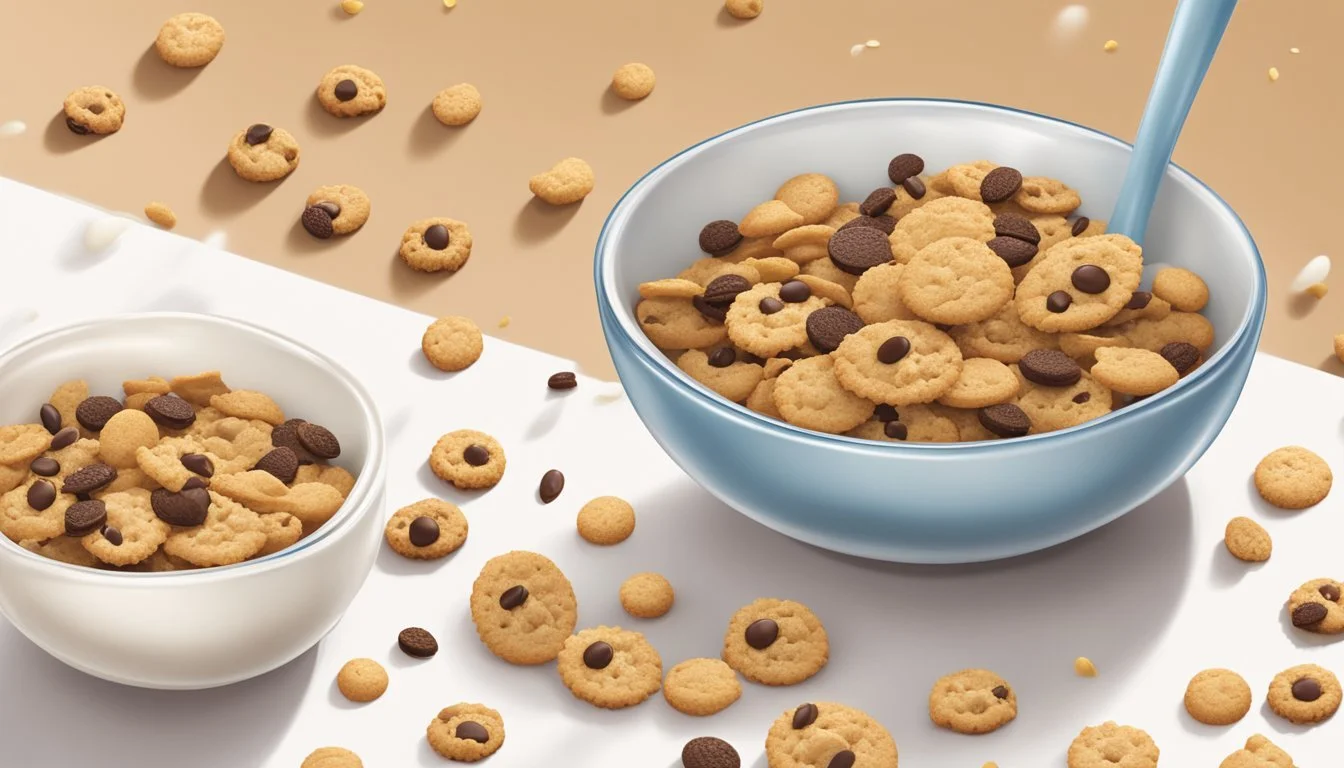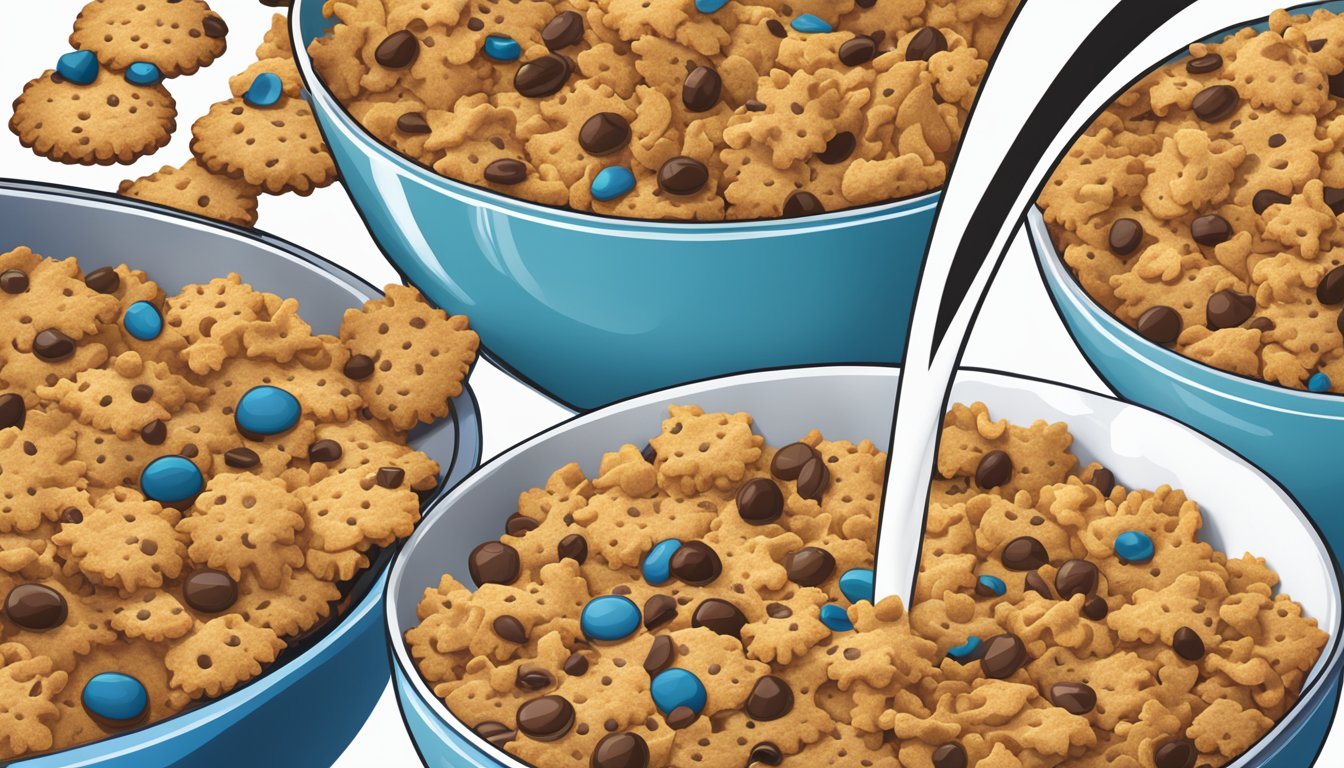Cookie Crisp vs Crispix
Comparing Breakfast Cereal Taste and Nutrition
This Article is Part of Our Breakfast Cereal Guide with Details on Cookie Crisp Nutrition and Crispix Nutrition
When it comes to choosing a breakfast cereal, Cookie Crisp and Crispix offer distinct options for different preferences. Cookie Crisp Cereal is richer in Zinc, Calcium, and Fiber, making it a choice for those looking to add a bit more nutritional value to their morning routine with a touch of sweetness. People often wonder if Cookie Crisp is made from real cookies—this appeals to the sweet tooth without overindulgence.
In contrast, Kellogg’s Crispix boasts higher levels of Folate, Iron, and several essential B vitamins, including B6, B2, B1, B3, and B12. Crispix's unique combination of cornflakes and rice provides a crispy texture that many cereal enthusiasts love, although it tends to get soggy quickly.
Comparing these cereals highlights the varied needs and tastes of breakfast lovers. Whether one prioritizes nutrient content or flavor innovation, both cereals offer specific benefits and delightful starts to the day.
Overview of Cookie Crisp and Crispix Cereals
Cookie Crisp and Kellogg's Crispix Cereal are two distinct breakfast options with different nutritional profiles and unique histories. Both cereals have gained popularity for their specific flavors and compositions, appealing to various consumer preferences.
Cookie Crisp Cereal History and Composition
Cookie Crisp is a breakfast cereal manufactured by General Mills. Introduced in 1977, it is designed to look like miniature chocolate chip cookies, enticing children and adults alike. The cereal's base ingredients include flour and corn, providing a satisfying crunch.
Each serving of Cookie Crisp contains about 12 grams of sugar, making it a sweeter cereal option. Despite its whole-grain base, it only offers 2 grams of fiber per serving, which is less than the recommended amount for breakfast cereals. Additionally, it is rich in minerals such as zinc and calcium.
Crispix Cereal History and Composition
Kellogg's Crispix Cereal was introduced in 1983. Known for its unique hexagonal shape, Crispix combines the flavors of rice and corn, creating a light and crispy texture. This dual-grain composition sets it apart from other cereals.
Crispix offers a better nutritional profile in terms of vitamins. It is high in folate, iron, and several B vitamins, including B1, B2, B3, B6, and B12. The cereal's low calcium content differentiates it from Cookie Crisp. Additionally, it is versatile, often used in various recipes such as snack mixes and cereal bars.
Nutritional Comparison
Both Cookie Crisp and Crispix offer distinct nutritional profiles that cater to different dietary needs and preferences. Key differences in their caloric value, macronutrient composition, and vitamin and mineral content can greatly influence your choice between these two cereals.
Caloric Value and Macronutrients
Cookie Crisp provides around 110 calories per serving, while Crispix offers slightly more at 150 calories per serving.
Protein:
Cookie Crisp: 2 grams
Crispix: 3 grams
Carbohydrates:
Cookie Crisp: 24 grams
Crispix: 35 grams
Fat:
Cookie Crisp: 1 gram (0.5 grams saturated)
Crispix: 0 grams
These numbers highlight that Crispix has more calories and carbohydrates, but lacks fat entirely.
Vitamin and Mineral Content
Crispix is notably richer in essential vitamins and minerals.
Vitamins:
Cookie Crisp: Higher in Vitamin C
Crispix: Higher in Vitamins B1, B2, B3, B6, and B12
Minerals:
Cookie Crisp: More Zinc and Calcium
Crispix: More Iron and Folate
Crispix’s vitamins contribute to energy metabolism and red blood cell formation, making it a potentially healthier option for those needing these nutrients.
Fiber, Sugars, and Fats Breakdown
Fiber:
Cookie Crisp: 1 gram
Crispix: 1 gram
Sugar:
Cookie Crisp: 10 grams
Crispix: 3 grams
Fats:
Cookie Crisp has a small amount of saturated fat (0.5 grams), while Crispix contains no fat, including saturated, monounsaturated, and polyunsaturated fats. This lack of fat in Crispix may be advantageous for those monitoring fat intake.
Cookie Crisp has a higher sugar content, which could be a consideration for those limiting sugar consumption. Crispix, on the other hand, offers a lower sugar alternative that still provides essential nutrients without the extra calories from fat.
Through these nutritional comparisons, the distinct differences between Cookie Crisp and Crispix become clear, helping you make a more informed choice based on your dietary needs.
Health and Diet Considerations
When choosing between Cookie Crisp and Crispix, health and diet considerations play an essential role. Comparing their nutritional profiles can help determine which cereal aligns better with specific dietary needs and restrictions.
Dietary Restrictions and Allergens
Crispix cereal consists of corn and rice, which are generally safe for individuals with common food allergies like gluten. It's essential to check the packaging for any cross-contamination warnings, particularly for those with severe sensitivities.
Cookie Crisp, on the other hand, contains ingredients like wheat and soy, common allergens. This makes it unsuitable for those with celiac disease or gluten intolerance. Allergy-prone individuals should read the ingredient list carefully for potential triggers.
Implications for Special Diets
For those on a low-fat diet, both cereals are relatively low in fat content. Crispix is often favored in *low-calorie diets because it contains fewer calories per serving compared to Cookie Crisp.
Crispix also has significantly lower sugar content, making it a suitable option for diets aimed at reducing sugar intake. In contrast, Cookie Crisp contains added sugars that can be a concern for those managing their sugar intake or following a low-sugar diet.
Glycemic Index and Blood Sugar Impact
The glycemic index (GI) measures how quickly carbohydrate-containing foods raise blood glucose levels. Foods with a lower GI are better for maintaining steady blood sugar levels. Crispix has a lower glycemic index compared to Cookie Crisp, making it a better choice for those managing blood sugar levels.
In contrast, Cookie Crisp tends to have a higher glycemic index due to its higher sugar content. This can lead to rapid spikes in blood sugar, which is not ideal for individuals with conditions like diabetes or those aiming for a low glycemic index diet.
These differences are crucial when considering cereals' impact on health and dietary goals.
Taste and Texture Profile
The taste and texture profiles of Cookie Crisp and Crispix differ significantly due to their unique ingredients and preparation methods. These variations affect how they appeal to individual preferences, focusing on sweetness, crunchiness, and overall mouthfeel.
Flavor Characteristics
Cookie Crisp aims to mimic the flavor of chocolate chip cookies in a cereal format. It has a strong, sweet taste with hints of chocolate and vanilla that appeal to those with a sweet tooth. The use of solid fat such as butter and ingredients with a low melting temperature provide a rich, indulgent flavor profile.
Crispix, on the other hand, has a more subtle flavor. It features a light, slightly sweet taste derived mainly from its corn and rice components. This gives it an unassuming but enjoyable flavor that pairs well with milk without overwhelming the palate.
Texture and Consistency Comparisons
Cookie Crisp offers a crunchy texture that closely resembles biting into small cookies. The cereal pieces maintain their crunch in milk, providing a consistent texture throughout the eating experience. This provides a satisfying crunch that mimics the texture of real cookies.
Crispix is known for its dual-texture experience, combining crispy corn on one side and crunchy rice on the other. This unique structure gives it a light, airy crunch that quickly softens in milk while still retaining some firmness. The breakfast cereal remains enjoyable without becoming too soggy too quickly.
Personal Taste Preferences
When it comes to personal taste, those who prefer a sweet, indulgent flavor may lean towards Cookie Crisp. Its cookie-like taste and consistent crunch make it a treat for anyone craving a dessert-like cereal in the morning.
Conversely, individuals who enjoy a more balanced and lighter flavor might favor Crispix. Its dual-texture and subtle sweetness make it a versatile option for breakfast, especially for those who prefer a cereal that doesn’t overwhelm the senses early in the day.
Versatility in Recipes
Both Cookie Crisp and Crispix offer a wide range of possibilities in cooking and snack recipes. While Cookie Crisp is primarily known for its role as a breakfast cereal, it can also be a fun and delicious ingredient in various desserts. Crispix, on the other hand, is celebrated for its adaptability in both sweet and savory dishes.
Cereal as an Ingredient in Cooking
Cookie Crisp can add a delightful crunch to desserts such as Chocolate Chip Cookies or Crispy Cookies. Incorporating these mini chocolate chip cookies into the cookie batter not only enhances the texture but also provides an added layer of sweetness. Cookie Crisp can be crushed and used as a topping for ice cream sundaes or blended into milkshakes for a rich, decadent treat.
Crispix is versatile and finds its place in numerous recipes beyond just being served with milk. Its unique dual texture makes it ideal for snack mixes that combine Nuts, dried fruits, and seasonings. For example, recipes like Cheesy Ranch Crispix Mix or Maple-Glazed Snack Mix capitalize on Crispix's crunch to create delicious, shareable snacks. The cereal can be used in baking as a base for bars or coated in chocolate for a simple treat.
Alternative Uses Beyond Breakfast
Cookie Crisp has creative uses that extend beyond traditional breakfast fare. It can be used to make a festive cereal treat bar, similar to rice crispy treats, with marshmallows and a bit of butter. Another approach is to use it as a crust for pies and cheesecakes by mixing crushed Cookie Crisp with butter and pressing into a pie dish.
Crispix is renowned for its role in savory dishes like Furikake Chex Mix, where it is combined with soy sauce and Fumi Furikake to create an Asian-inspired snack. Additionally, Crispix can be used as a breading substitute for fried or baked chicken, offering a lighter and crunchier texture than traditional breadcrumbs. The cereal's versatility truly shines as it adapts to various culinary styles, from sweet snacks to savory sides.
Market Position and Brand Perceptions
Kellogg's Crispix has carved a niche in the cereal market with its unique combination of crispy rice and crunchy corn, while Cookie Crisp captures the nostalgia and indulgence associated with cookies.
Consumer Loyalty and Brand Strength
Kellogg's Crispix has built strong consumer loyalty due to its distinctive texture and dual-grain composition. The cereal appeals to those seeking both a light and crunchy breakfast option. Over the years, Crispix has maintained a steady customer base by focusing on quality and a health-conscious profile.
Cookie Crisp enjoys brand strength through its appealing concept of eating cookies for breakfast. This playful angle particularly attracts children and adults who seek a fun and satisfying cereal experience. Despite facing competition, Cookie Crisp maintains its presence by leveraging its unique position in the market.
Price Comparison and Economic Considerations
When considering price, Crispix and Cookie Crisp vary. Crispix has a competitive price point, designed to attract budget-conscious consumers who do not wish to compromise on quality. Generally, it is perceived as offering good value, especially given its nutritional benefits compared to other cereals.
On the other hand, Cookie Crisp Cereal might be priced slightly higher due to its branding and appeal. This cereal taps into the indulgence market, where consumers are willing to pay a bit more for a satisfying and unique experience. Despite the price difference, both cereals manage to retain their respective consumer segments effectively.
Comparative Analysis with Other Cereals
In comparing Cookie Crisp and Crispix to other cereals, nutrient content and flavor profiles are key considerations. Cookie Crisp offers a chocolatey, indulgent taste while Crispix provides a unique combination of rice and corn.
Cookie Crisp vs. Other Chocolate Cereals
Cookie Crisp is often compared to other chocolate cereals like Cocoa Puffs and Krave. Cocoa Puffs contains a slightly higher sugar content, making it sweeter but also less healthy. Krave cereal balances a chocolate filling with a crunchier outer shell, providing a different texture.
Mini Wheats and Honey Bunches of Oats do not focus on chocolate but offer higher fiber content, which helps in digestive health. Cinnamon Toast Crunch, with its cinnamon-sugar coating, offers a similarly indulgent experience but with a slightly different flavor profile. Cookie Crisp's combination of sweetness and calcium-rich content makes it a favorite for those who prioritize taste alongside some nutritional benefits.
Crispix vs. Other Corn and Rice Cereals
Crispix combines corn and rice, offering a light and crispy texture that can hold up well in milk. Compared to Rice Krispies, which focuses solely on rice, Crispix offers a more diverse flavor experience with its dual-grain composition. Corn Flakes provides a simpler, corn-only flavor which is less sweet and often seen as more versatile for various recipes.
Chex provides a broader variety with options like corn, rice, and wheat, giving Crispix a run for its money in terms of versatility. Special K offers high protein and is often marketed towards adults with a focus on health benefits. Frosted Flakes and Pops lean more towards sweetness and less on nutritional gains. This balance of taste and nutrition gives Crispix a unique standing among cereals combining corn and rice.








